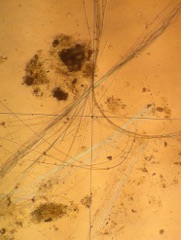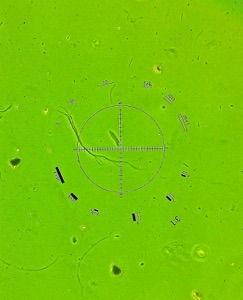
Asbestos Analytical Methods
Polarized Light Microscopy (PLM) is a low cost method for determining asbestos in building materials based on differences in optical properties of the fiber in its long direction versus its short direction(s). Due to the arrangement of atoms into different molecules and due to different geometries of the molecules in different directions, light is transmitted at different wavelengths down different axis of the crystals. Asbestos fibers have characteristic morphologies and colors but these properties may not be definitive. The use of polarized light in conjunction with mounting medium with specific optical properties, and with special accessories on the microscope that alter the light coming or going through the crystal, produce definitive color changes that identify the mineral.
All samples are analyzed by the method 40 CFR Part 763 Appendix E, Section 1 Polarized Light Microscopy (PLM) which is the current analytical method specified in asbestos regulations by the Oregon DEQ. Where appropriate, analytical procedures outlined in the EPA 600/R-93-116 Method for the Determination of Asbestos in Bulk Building Materials (July 1993) are used as this method is considered an improvement on the original analytical method. The improved method provides options for additional quantification or different analytical methods for some types of materials that may be difficult to analyze by the standard method. A lower detection limit by standard PLM analysis by either of these methods of less than 1% asbestos is achievable by skilled technicians participating in rigorous QA/QC programs.
Fibers less than 1 micrometer in length are not detectable by PLM. Point counting is required by NESHAPS (40 CFR Part 61) for quantitation of samples containing less than 10% asbestos by PLM analysis only when materials are not treated as asbestos containing material (ACM). Samples reported by BULLSEYE as containing 1% or less asbestos by standard PLM may require point count verification or additional quantification at an additional cost. The BULLSEYE Precision Analytical and Environmental Services laboratory participates in quality assurance and quality control programs including inter-laboratory and intra-laboratory QA/QC procedures recommended by the EPA, but is not NVLAP accredited. NVLAP accreditation is required for samples analyzed as part of a school’s AHERA Management Plan. Bullseye analysts are registered geologists with a minimum of three years experience in a NVLAP or AIHA accredited laboratory and are specifically trained in mineral identification, not just asbestos identification.


These are views of same amosite and chrysotile fibers at 100X mounted in 1.550 refractive index oil in plane polarized light, with addition of 1/4 wavelength accessory plate, and under dispersion staining objective. Because the refractive index (optical density) of the chrysotile matches that of the oil, the characteristic blue and magenta dispersion staining colors for chrysotile can be seen in the photo at far right. To see the dispersion staining colors of the amosite, mounting the fibers in 1.680 RI index oil is required. (These photos were taken by pointing an iPhone camera down one of the oculars of the microscope with no holder or special attachment!)
PHASE CONTRAST MICROSCOPY (PCM) uses special accessories on the microscope to make very thin fibers more visible. Light waves are bent (diffracted and shifted in phase) after passing through the specimen. The phase contrast accessories amplify the phase shift. providing greater contrast between the specimen and the mounting medium when viewed through the eyepieces of the microscope. Fibers are viewed and counted at 400X magnification. The method is used to analyze asbestos fibers collected on an air sampling cassette containing a special filter. Air is drawn through the cassette using a pump calibrated for known flow rates and minimum air volumes defined by the analytical method (NIOSH 7400). The filters are then dissolved in acetone vapor and mounted on a microscope slide. The analytical method is not fiber specific and counts all fibers in a specified range according to counting rules defined by the method. Results are reported in total fibers per cubic centimeter of air. Although the method counts all fibers present, not just the asbestos, the results are used to determine if workers have been exposed to asbestos levels above the Permissible Exposure Limit. The PEL is defined as 0.1 f/cc when calculated as an 8 hour time weighted average and 1.0 f/cc over a sampling period of 30 minutes (also known as the Excursion Limit). Air samples are also used to determine whether the air following asbestos abatement (removal by a licensed asbestos abatement contractor) has achieved a ‘clearance level’ below 0.01 f/cc.
Chrysotile fibers at 400X under PCM Microscope.
When using air sampling data to determine whether someone has been exposed to asbestos or not, interpreting the numbers may not be that easy. Asbestos fibers may remain airborne for some time (30 days) but air movement through the area may also quickly dilute fibers that may have been released during an accidental disturbance. Airborne concentrations days or even hours later may be significantly different then during the actual release event. Most homes and businesses have background levels of fibers in the air above the 0.01 f/cc clearance level due to the presence of paper and other types of non-asbestos fibers.

